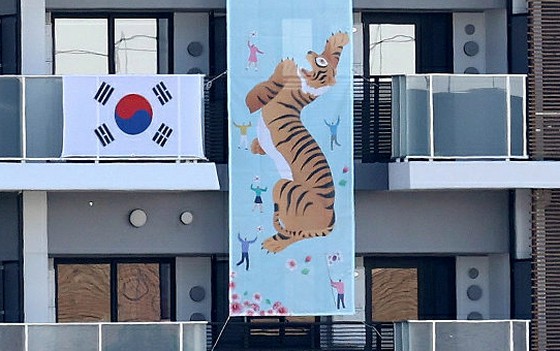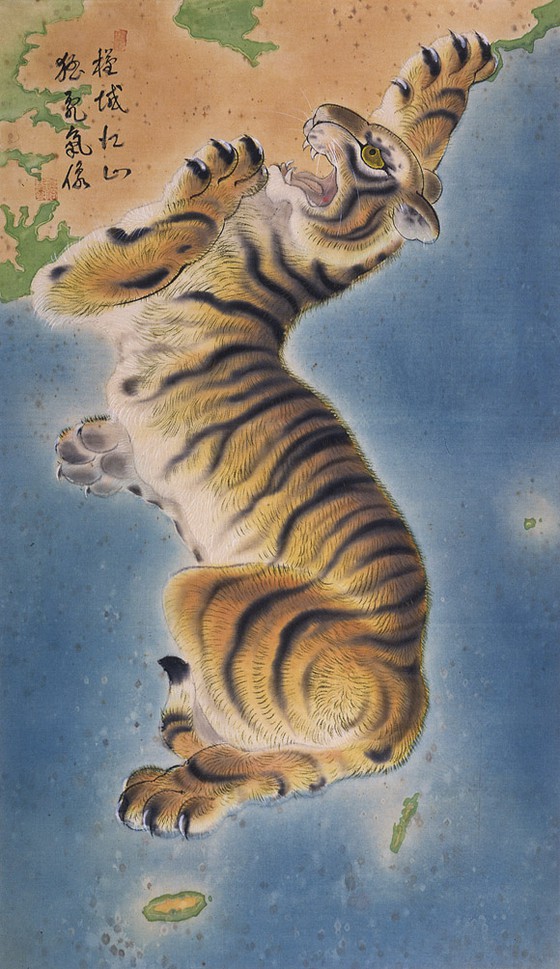  |
Prior to this, the Korean team had put up a banner in the Olympic Village, which featured a quote spoken by General Lee Sun-sin, who is said to be an "anti-Japanese hero," but the Olympic Charter 50 prohibits political publicity. It was removed on the 17th at the request of the International Olympic Committee (IOC).
The newly raised banner depicts the Korean Peninsula in the shape of a tiger, along with the words "Tiger is coming down." "Tiger is coming down" is a passage from the Korean traditional performing arts Pansori "Sugungga".
In Korea, tigers have long been sacred as a symbol of dignity and bravery because of their appearance. Since many tigers once lived on the Korean Peninsula, they were also familiar to people. Therefore, tigers appear in various situations.
The founding myth of Dangun, which every Korean knows, is the story of a tiger and a bear who came under God in hopes of becoming human.
There are many sayings in Korea where tiger is used, the saying used to mean "not knowing one's social position" is "a newborn puppy does not know the fear of tigers" (Literal Translation). The proverb in Japanese "gold stick for a demon" which means "To take something that was already powerful, and make it even more so" becomes "wings on a tiger L (Literal Translation), and it can be seen that the tiger is regarded as "a strong existence no less than anything".
Regarding the Olympics, the 1988 Seoul Olympics, the 2018 Pyeongchang Olympics, and the Olympics held in South Korea so far mascots had a tiger motifs.
The Seoul Olympics mascot "Hodori" character profile was a "Tiger Boy". In addition to tigers, rabbits, squirrels, and mandarin ducks remained as finalists, but it was still the tiger that was adopted as the mascot for the first Olympics held in South Korea. The mascot of the Pyeongchang Olympics was "Suhoran" with a white tiger motif.
On the other hand, in the history of tigers and Japan, there is an anecdote that Kiyomasa Kato, a military commander, exterminated tigers when he was sent to Korea by order of Hideyoshi Toyotomi in the 1590s.
The banner, which was removed at the request of the IOC last week because the phrase "There are still 12 ships left in the vassal" left by Lee Sun-sin (Yi Sun-sin) who resisted when Toyotomi Hideyoshi sent troops to Korea, was written. It was also reported by the Japanese media as "Anti-Japanese banner".
This time, the Korean media reported that the banner that was newly set up in the Olympic Village "has the meaning of igniting the power of the team." If you use "historically popular animals" as a mascot for support, it doesn't matter. But if the political intent is hidden there, the story is different.
If the scary things in the archipelago were "earthquakes, lightning, and fires," the scary things in the Korean Peninsula were "tiger disease and mother." "Tiger disease" is the damage caused by a tiger, and "mother" is smallpox. It is modernization and has deep ties to Japan that have liberated the people of the peninsula, who have historically been exposed to these two horrors.
The tigers were hunted and went extinct during the Japanese colonial rule under the "Vermin Extermination Policy" of the Government-General of Korea. Smallpox was eradicated by Korean doctor Ji Suk-young (Ikesinaga) who was taught the vaccination method by a Japanese doctor who was active in Busan.
However, after South Korea became independent, a new "anti-Japanese myth" was born in the process of anti-Japanese education. It is said that the "national spirit" of Korea was cut off because the Japanese emperor (Japanese imperialism) ruled the peninsula forever. It is a myth that the Japanese emperor made tigers go extinct, which is a symbol of the people and protected the sacred mountain of the people, and struck an iron nail in the sacred mountains of the peninsula where the souls of the people flows.
The Japanese emperor built a modern school on the peninsula. The appendix also mentions that in the primary education, the original map of the peninsula, which had a dignified "tiger shape", was colonized as a soft "rabbit shape". In order to remove those "remains of the Japanese Empire", "National School" was renamed to "Primary School" and the textbook was revised.
In order to revive the "ethnic pulse" that flows through the peninsula, the movement to climb mountains all over the country to find and remove iron nails, and work continued to compare the genes remaining in the stuffed tigers with the genes of the Siberian tiger in order to restore the Korean tiger.
It is unsure whether the banner is "pure support" or "political intent". Isn't there a hint in the "Tiger is coming down" part of Pansori "Sugungga"?
Sugungga's turtle deceived the rabbit and headed for the mountain to take his liver. The tired turtle mistakenly called the "rabbit student" a "tiger student". The turtle, which was in danger of being eaten by a tiger that appeared in a dignified appearance, bit the tiger's genitals. The surprised tiger fled to Uiju.
Uiju is the border between the peninsula and the continent, and is also the place where the King of Korea, Seonjo, who was attacked by Toyotomi Hideyoshi's Japanese army, was waiting for asylum in China. It is now famous as Sinuiju City, where border trade between China and North Korea is active.
At least the people of the late Joseon Dynasty, who enjoyed the "Sugungga song," did not seem to think of this tiger as a "spirit that protects the spirit of the people." It may have been recognized as the Joseon dynasty itself, which has been defying the people with the power it has maintained while contributing to the Qing dynasty of the continent.
By the way, the map of the peninsula was represented as a tiger in 1908, when the "Maki area Eyama Taketora Meteorological Map" began. The banner this time is also redrawn. The author, Choi Nam-seon, is a person who is listed in the "Dictionary of Pro-Japanese Names" and is classified as "Chinilpa". If it is a pro-Japanese work, it is not like Korea trying to change the nation and national flag. "There is no future for people who have forgotten history."
2021/07/22 21:17 KST


